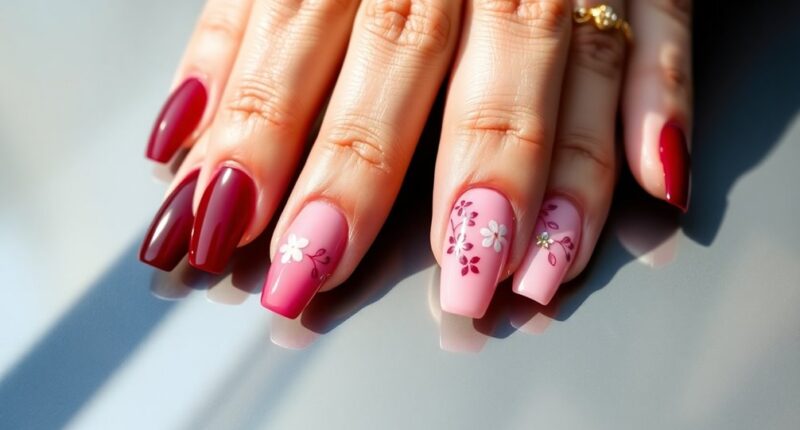Gel nails are a popular choice for enhancing your natural nails. They provide a durable and glossy finish that lasts 2 to 3 weeks with proper care. You can choose from different types like soft gels, hard gels, or builder gels, each offering unique benefits. The application involves curing layers of gel polish under UV or LED light. While they're generally low in odor and non-toxic, there are some factors to reflect upon. Learn more about their pros, cons, and maintenance tips.
Key Takeaways
- Gel nails are a type of manicure that uses gel-based polish cured under UV or LED light for a durable and glossy finish.
- There are three main types of gel nails: soft gels, hard gels, and builder gels, each serving different purposes.
- Gel polish typically lasts 2 to 3 weeks, requiring minimal maintenance to prevent chipping and maintain luster.
- The application process involves prepping the nails, applying a base coat, multiple layers of color, and a top coat, all cured under light.
- Gel nails are generally odorless and non-toxic, making them suitable for individuals sensitive to strong smells.
Definition of Gel Nails
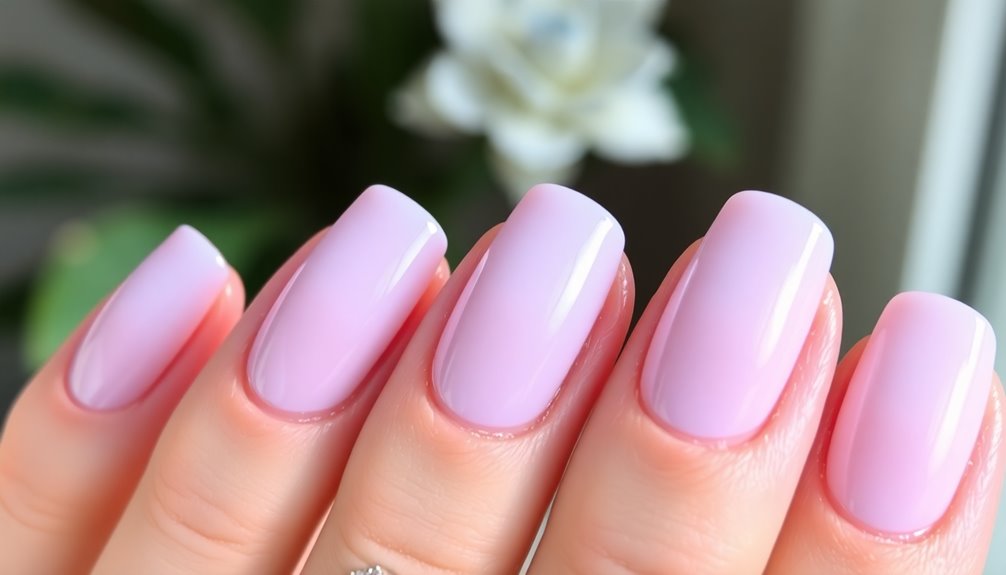
Gel nails are a popular choice for those seeking a durable and glossy finish for their nails. These artificial nails or overlays are applied over your natural nails, enhancing both strength and appearance.
The process involves using gel polish, which is a semi-permanent polish that lasts longer than traditional nail polish, typically around 2 to 3 weeks. You'll find that gel nails provide a more natural look due to their flexibility and sheen.
Each manicure involves applying 2-3 coats of gel polish, which must be cured under UV or LED light for quick drying. This curing process makes gel nails a convenient option, ensuring you enjoy a stunning and long-lasting durable finish with minimal maintenance. Additionally, gel nails may require special care to maintain their luster and prevent chipping over time.
Types of Gel Nails
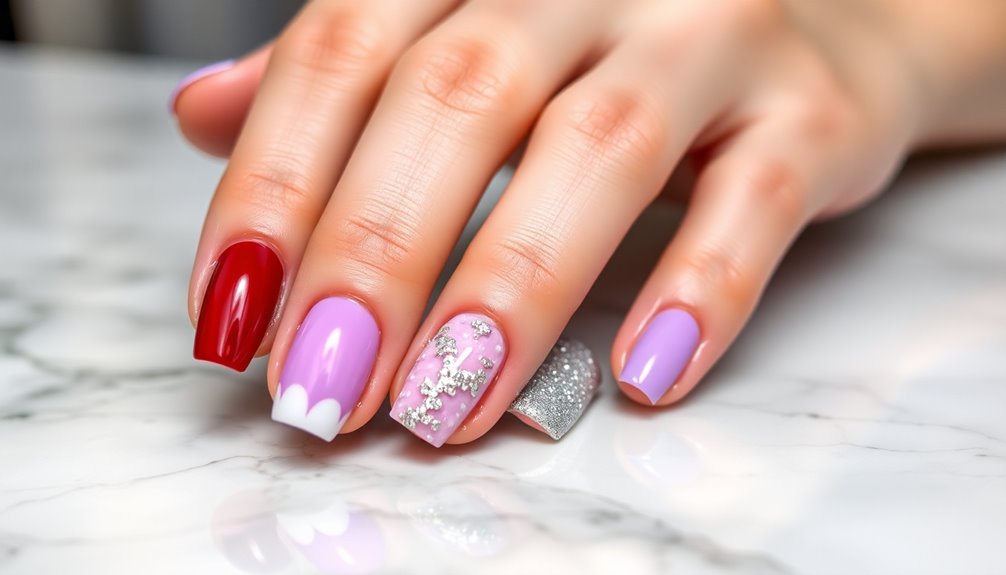
When choosing gel nails, you'll encounter various options tailored to your needs.
Soft gels offer easy application and self-leveling properties, perfect for shorter enhancements, while hard gels provide durability and structure for longer-lasting looks. Additionally, builder gels are essential for creating a strong foundation, making them popular among those seeking both strength and style. It's important to use high-quality tools for optimal application and longevity of your gel nails.
Soft Gel Variations
Soft gel variations, often referred to as soak-off gels, provide a flexible and glossy finish that makes them a popular choice for manicures.
These soft gels are perfect for structured manicures, thanks to their self-leveling properties that enhance the natural look of your nails.
You'll appreciate their flexibility, which allows for easy layering over hard gels without sacrificing durability.
One specific type is rubber base gels, offering added viscosity to help with rebalancing without complete removal.
Popular brands like Gelish, Bio Sculpture, and Vetro cater to the growing trend of gel enhancements.
With their versatile applications, soft gels are an ideal choice for those seeking beautiful and long-lasting nails. Additionally, these gels can be safely applied and removed, aligning with the safety standards for children's toys to ensure a worry-free experience.
Hard Gel Characteristics
Hard gel nails stand out for their firm, durable finish, making them a preferred choice for extensions or overlays. To achieve this strong structure, you'll need a UV light during the curing process, which helps hard gel set properly.
The application starts with a bonder and a base coat, enhancing adhesion and ensuring a long-lasting look. Hard gels have a thicker viscosity compared to soft gels, providing a substantial layer over your natural nails.
However, unlike soft gels, you can't soak hard gels off in acetone; their removal usually involves filing them down. This characteristic makes hard gels ideal for those seeking a resilient, enduring manicure that maintains its shape and strength over time.
Builder Gel Applications
Builder gel, often referred to as structure gel, offers versatile applications that cater to both nail enthusiasts and professionals alike.
You can use builder gel to create a solid nail structure, whether you're opting for soak-off or non-soak-off formulas. It's available in different viscosities, allowing you to apply it in layers for added length and shape, or to reinforce nail enhancements.
This gel can serve as an overlay on natural nails or as a base for nail extensions, providing a durable alternative to traditional acrylics.
Remember, builder gel requires curing under UV light to guarantee a strong bond, enhancing the durability of your manicure. Additionally, maintaining proper airflow around the curing unit can enhance the effectiveness of the process.
Popular brands like Gelish, Bio Sculpture, and Vetro offer excellent compatibility across various nail systems.
Application Process for Gel Nails
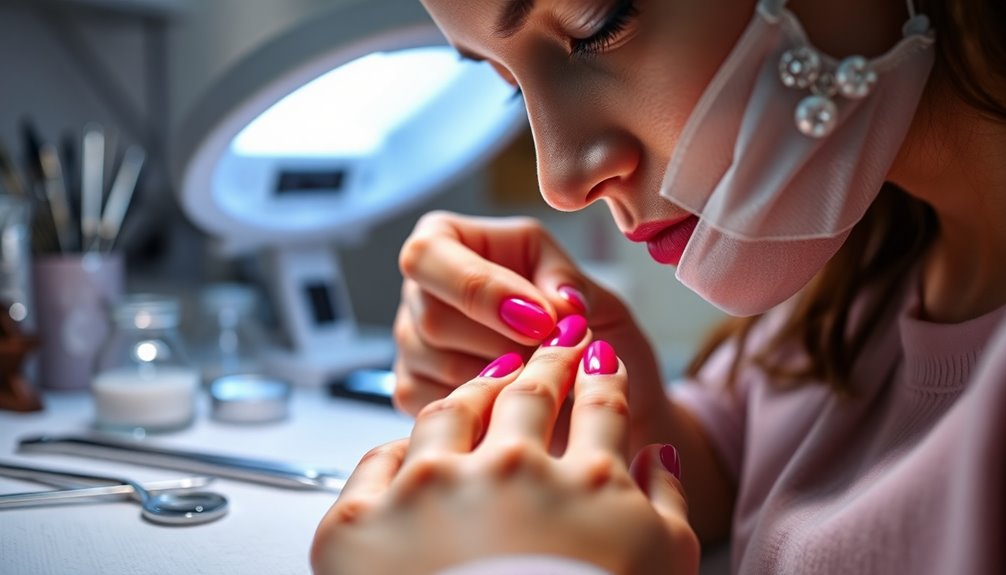
When you're ready to apply gel nails, the process starts with prepping your natural nails by cleaning and buffing them.
You'll then apply a base coat, followed by 2-3 layers of colored gel polish, curing each layer under a UV or LED light.
Finally, a glossy topcoat seals everything in, giving you a beautiful, shiny finish that's ready to go. It's important to ensure that your nails are in good health before application, as essential oils for nail health can help maintain optimal condition.
Steps for Application
To achieve a flawless gel nail finish, you'll want to follow a straightforward application process.
Start by applying a bonder to guarantee proper adhesion, followed by a base coat.
Once that's set, apply 2-3 thin coats of gel polish, curing each layer under a UV or LED lamp for about 30 to 60 seconds. This step is essential for the polish to adhere well and maintain durability.
After the final coat of gel polish, finish with a glossy top coat, which also requires curing. This step not only adds shine but also enhances the longevity of your manicure. Regular maintenance of your gel nails, including proper upkeep and timely touch-ups, can further extend their beautiful appearance.
With these simple steps, your gel nails will look stunning and last beautifully!
Curing Process Explained
The curing process is a critical step in achieving beautiful gel nails, as it transforms the liquid gel polish into a hard, durable finish. Each layer of gel polish needs to be cured under a UV lamp or LED light for 30 to 60 seconds. This guarantees your nails dry instantly, providing a glossy and longer-lasting outcome. Additionally, using a base coat is essential for protecting your natural nails during the application.
| Layer Type | Curing Time | Finish Type |
|---|---|---|
| Base Coat | 30-60 seconds | Hard Gel |
| Gel Polish | 30-60 seconds | Glossy Finish |
| Top Coat | 30-60 seconds | Soft Gels |
Proper curing is essential. Inadequate curing can lead to chipping or peeling, so always follow these steps to keep your gel nails looking fabulous!
Pros and Cons of Gel Nails

While gel nails offer a stunningly realistic look and longer-lasting wear, they come with their own set of pros and cons.
One major advantage is their natural appearance, which can enhance the overall aesthetic of your nails. Gel manicures are also odorless and non-toxic, making them a great option for those sensitive to strong smells.
However, you should consider the higher cost, typically starting at around $40 to $45 for a basic gel manicure.
Another downside is the use of UV dryers during the curing process, which pose risks of skin damage.
Ultimately, weighing these pros and cons will help you decide if gel nails are right for you. Additionally, exploring cruelty-free products can provide you with more ethical beauty choices when it comes to nail care.
Safety Considerations for Gel Nails
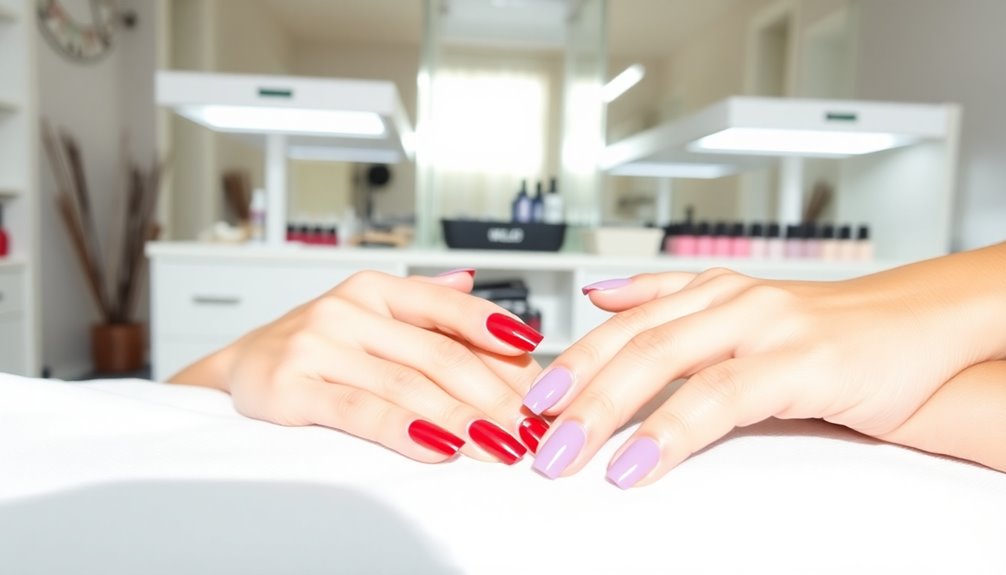
When considering gel nails, it's important to keep safety in mind. UV light exposure during gel nail curing has been linked to skin cancer, so using UV protection on your hands is highly recommended.
Opt for salons that use LED lamps, as they emit less UV radiation. Proper removal techniques are essential; avoid peeling and use acetone carefully to protect your natural nail bed and cuticles.
Taking regular breaks between gel applications helps maintain nail health and prevents weakening.
Finally, verify the sterilization of tools is a priority at your salon to minimize the risk of infections and complications. Additionally, maintaining skin hydration is crucial for overall nail and skin health during gel nail use.
Differences Between Gel and Acrylic Nails
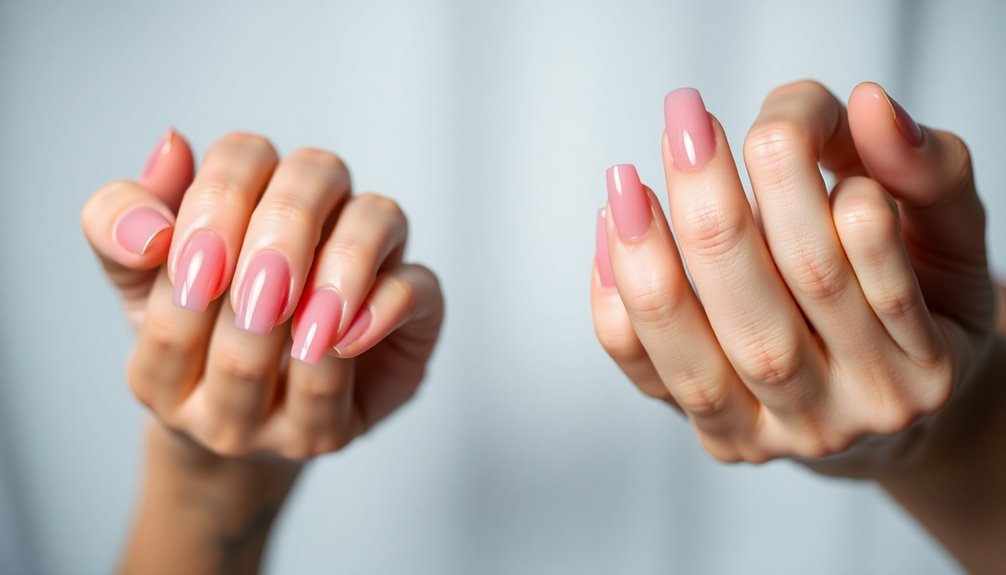
Understanding the differences between gel and acrylic nails can help you choose the best option for your style and needs.
Gel nails are created using a gel-based polish that requires curing under UV or LED light, providing a flexible, natural appearance. In contrast, acrylic nails involve a mixture of liquid monomer and powder polymer, curing instantly in the air.
The application process for gel manicures typically requires 2-3 coats of polish, each cured for 30 to 60 seconds, while acrylics are sculpted and dry quickly.
Although gel nails usually last 2 to 3 weeks, acrylics may last longer due to their durability.
If you're sensitive to strong smells, gel nails are generally odorless and less toxic, making them a preferred choice. Additionally, individuals with emotional instability may find that gel nails offer a less stressful and more enjoyable pampering experience.
Tips for Maintaining Gel Nails

Maintaining gel nails is key to keeping them looking fresh and flawless. To keep your nails in top shape, avoid exposing them to harsh chemicals commonly found in cleaning products, as they can weaken the gel and lead to chipping.
Regularly apply cuticle oil to hydrate your nails and prevent peeling or lifting. Schedule touch-ups or infills every 3 to 4 weeks to address nail growth and maintain the polished look.
If you engage in activities that cause wear and tear, don't hesitate to wear gloves for protection.
Finally, when it's time to remove gel polish, seek professional help or follow proper at-home techniques to avoid damaging your natural nails.
With these tips, you can effortlessly maintain gel nails.
Frequently Asked Questions
Are Gel Nails Better Than Acrylic?
When you're deciding whether gel nails are better than acrylic, consider your lifestyle and preferences.
Gel nails offer a more natural look, are less damaging to your natural nails, and cure quickly under UV or LED light. They're also less odorous and safer for those sensitive to fumes.
However, if you need longer-lasting wear, acrylics might be your better option.
Ultimately, it's about what fits your needs best.
What Is the Downside of Gel Nails?
When considering gel nails, you might face a few frustrating factors.
First, their cost can create a budget barrier.
Next, the UV curing process poses potential skin dangers, similar to sun exposure.
You'll also find that their durability might disappoint, as they can shatter rather than crack.
Finally, the removal process can leave your nails feeling flimsy and fragile, potentially leading to discomfort or sensitivity.
Weigh these downsides before deciding!
Are Gel Nails False Nails?
Yes, gel nails are considered false nails.
When you apply a gel product over your natural nails, you're enhancing their appearance and strength artificially. This process involves curing the gel under UV or LED light, which differentiates them from other nail enhancements.
While they offer a glossy finish and can be applied as overlays or extensions, they still require skilled application to guarantee they adhere properly and minimize potential damage to your natural nails.
Do Gel Nails Damage Your Nails?
Yes, gel nails can damage your natural nails if they're not applied or removed properly.
The buffing process weakens your nail surface, and if you use acetone for removal, it can lead to dryness and brittleness. Your nails might feel flimsy or sensitive afterward, especially if you've only applied gel overlays to the tips.
To minimize damage, avoid peeling and consider having them removed professionally, giving your nails a break in between applications.
Conclusion
In the world of nail art, gel nails offer a glossy, vibrant finish that catches the light like a freshly polished car. With their durability and stunning appearance, they're perfect for making a statement. However, remember to care for them like a delicate flower, ensuring they stay beautiful and healthy. So, whether you're flaunting a chic manicure at a gala or a casual brunch, gel nails can be your ticket to effortlessly glamorous hands.
